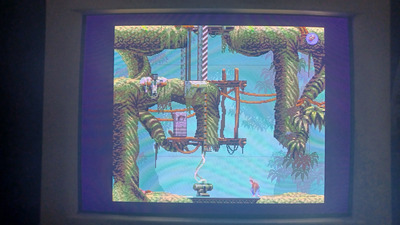ZellSF wrote on 2022-04-08, 09:31:I hate this particular way of people trying to determine aspect ratio for two reasons: […]
Show full quote
Silanda wrote on 2020-10-08, 13:12:Flashback's a good example because at 4:3 ratio the Mega Drive/Genesis version looks like the top picture. The problem is that there are some parts of the art, such as that blue thing around the selected item in the top right corner and some fans in the background of the second level, that look like they should be circular but are stretched into ovals.
I hate this particular way of people trying to determine aspect ratio for two reasons:
1) Smaller art is more difficult to correct aspect ratio for. That a small sprite isn't aspect corrected, doesn't mean the game and other art isn't.
2) People assume any abstract art must be spherical or square. I mean, how do you know they art designer didn't want that to be oval?
I'm fine with the "looks better for me" crowd, but the people using weird arguments like that to argue a game was designed for an aspect ratio that was never actually used is a bit weird. On a general basis of course, when it comes to cross platform ports like Flashback then you often need to use the original release for reference since ports often tend to screw with aspect ratio.
Oh it's certainly an imperfect way to determine anything, and I don't think abstract shapes alone to point to anything. With Flashback though, there are multiple objects that exist in real life that look horizontally stretched in-game at 4:3 ratio (e.g. ventilation fans, stars, planets, the Sega logo, possibly the Delphine logo, etc), and I do think it provides a basis to question whether the pixel aspect ratio vs display aspect ratio was taken account of. I'll admit though that I could be completely wrong, and the appearance could be down to low resolution or an oval fetish.
I think the art looks better at 1:1 and personally I think that objects that exist in reality appearing stretched suggests intent although it's not strong evidence. Can I be certain that all of the art was designed that way though? No. Can I be certain that any of the art was designed that way? Again, no. We'll never really know unless someone asks the artists and they remember their thinking from 30 years ago (or they have original design sketches).
As for using the original version to determine things, well, there are a few wrinkles there. The original version (though not the first released) was the Mega Drive/Genesis version. Firstly, was the system's PAL or NTSC output what the game's art was designed for? The PAL system has slightly more vertical resolution, leading to letterboxing and a slightly squashed ratio as most games don't take advantage of the extra height. It would seem unlikely that the art would assume a PAL aspect ratio but the developers were in a PAL region so it's not impossible.
Then there's horizontal overscan. The Genesis/Mega Drive has side borders that were usually hidden in the overscan region present in TVs of the day. Was the art designed to take that into account though, because if the console's output is displayed at 4:3 but with those borders visible (like it is using a modern TV or perhaps an RGB monitor back in the day) then it looks near as dammit like the second picture.


